
Lupinus polyphyllus, the large-leaved lupine, big-leaved lupine, many-leaved lupine, blue-pod lupine, or, primarily in cultivation, garden lupin, is a species of lupine (lupin) native to western North America from southern Alaska and British Columbia east to Quebec, and western Wyoming, and south to Utah and California. It commonly grows along streams and creeks, preferring moist habitats.

Lupinus sparsiflorus is a species of lupin native to North America. In the United States it occurs in California, Nevada, Arizona and Utah, and in Mexico it is found in Baja California and Sonora. Other common names include Mojave lupine, a name it shares with Lupinus odoratus.

Lupinus perennis is a flowering plant in the family Fabaceae. It is widespread in the eastern part of the USA and Minnesota, Canada, and on the coasts of the Arctic Ocean, where it grows in sandy areas such as dunes and savannas.
Lupinus latifolius var. barbatus, the Klamath lupine, sometimes also called bearded lupine, is a very rare plant of the Western U.S., known only from northeastern California and southeastern Oregon. It is a rare variety of the generally common species L. latifolius, which is a member of the bean family.
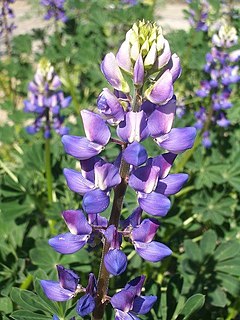
Lupinus succulentus is a species of lupine known by the common names hollowleaf annual lupine, arroyo lupine, and succulent lupine.

Lupinus bicolor is a species of lupine known as the miniature lupine, Lindley's annual lupine, pigmy-leaved lupine, or bicolor lupine.

Lupinus albifrons, silver lupine, white-leaf bush lupine, or evergreen lupine, is a species of lupine (lupin). It is native to California and Oregon, where it grows along the coast and in dry and open meadows, prairies and forest clearings. It is a member of several plant communities, including coastal sage scrub, chaparral, northern coastal scrub, foothill woodland, and yellow pine forest.
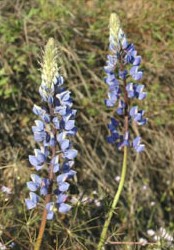
Lupinus benthamii is a species of lupine known by the common name spider lupine.
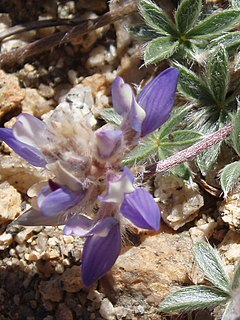
Lupinus breweri is a species of lupine known by the common names Brewer's lupine and matted lupine. It is native to much of California, except for the deserts, and to adjacent sections of Oregon and Nevada, where it is common in some areas, particularly mountain forests. Quite short for a lupine, this is a hairy, mat-forming perennial herb, sometimes becoming like a shrub, with a woody base. The leaves spread out from the stem. Each palmate leaf is made up of 5 to 10 woolly leaflets each up to 2 centimeters (0.79 in) long. The inflorescence is a dense raceme of flowers a few centimeters tall, each flower 4 to 11 millimeters. The flower is blue or purple with a white or yellowish spot on the banner. The fruit is a silky-hairy legume pod 1 or 2 millimeters long.
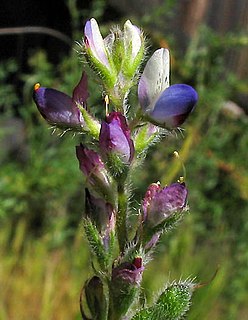
Lupinus concinnus is a species of lupine known by the common name Bajada lupine. It is native to the southwestern United States from California to Texas, and northern Mexico, where it is known from many types of habitat. This is a hairy erect or decumbent annual herb with a stem growing 10 to 30 centimeters long. Each small palmate leaf is made up of 5 to 9 leaflets up to 3 centimeters long and under a centimeter wide, sometimes narrow and linear in shape. The inflorescence is a dense spiral of flowers, with some flowers also appearing in leaf axils lower on the plant. Each flower is 5 to 12 millimeters long and purple, pink, or nearly white in color. The fruit is a hairy legume pod around a centimeter long.
Lupinus elatus is a species of lupine known by the common name tall silky lupine. It is endemic to California, where it is known from the Transverse Ranges above Los Angeles, and possibly also from the southernmost slopes of the Sierra Nevada. Its habitat includes dry areas in the forests of the mountains. This is an erect perennial herb reaching a maximum height near 90 centimeters. Each palmate leaf is made up of 6 to 8 leaflets up to 8 centimeters long. The herbage is coated in silvery silky to woolly hairs. The inflorescence is a long raceme of flowers, each about a centimeter long and arranged in whorls. The flower is purple or blue with a pale yellow patch on its banner. It yields a legume pod 2 or 3 centimeters long. This is a host plant to the Southern California native butterfly subspecies known as the San Gabriel Mountains Arrowhead Blue.

Lupinus flavoculatus is a species of lupine known by the common name yelloweyes, or yellow-eyed lupine.,

Lupinus guadalupensis is a rare species of lupine known by the common name Guadalupe Island lupine. It is known only from San Clemente Island, one of the Channel Islands of California, and Guadalupe Island off the coast of Baja California. It is a member of the coastal scrub growing alongside other island endemics and more common plants. This is an annual herb growing 20 to 60 centimeters high. Each palmate leaf is made up of 7 to 9 narrow leaflets up to 5 centimeters long and just a few millimeters wide, sometimes linear in shape. The inflorescence bears whorls of flowers each about a centimeter long and blue in color with a white banner patch which may fade pink. The fruit is a very hairy legume pod up to 6 centimeters long and about one wide. It contains 6 to 8 seeds.
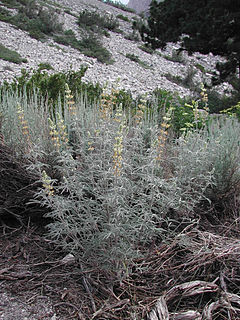
Lupinus padre-crowleyi is a rare species of lupine known by the common names DeDecker's lupine and Father Crowley's lupine. It is endemic to California, where it is known only from the eastern slopes of the Sierra Nevada and the high plateau below along the western border of Inyo County. It grows in the granite soils of the mountain forests and scrub. It has been noted at fewer than 20 locations. This is a perennial herb growing an erect inflorescence from a mat of silvery, woolly-haired herbage, reaching maximum heights over half a meter. Each palmate leaf is made up of 6 to 9 leaflets up to 7.5 centimeters long. The inflorescence is a raceme of whorled flowers each just over a centimeter long. The flower is cream to pale brownish yellow in color. The fruit is a silky-haired legume pod containing black-mottled white seeds.
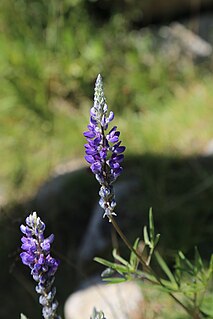
Lupinus pratensis is a species of lupine known by the common name Inyo meadow lupine. It is endemic to California, where it grows in the central Sierra Nevada and adjacent plateau and valleys to the east. It grows in relatively moist habitat, such as streambanks and spring meadows. This is an erect perennial herb growing 30–70 centimetres (12–28 in) tall. Each palmate leaf is made up of 5 to 10 narrow leaflets sometimes exceeding 10 centimetres (3.9 in) long. The leaves are borne on long petioles which can reach 25 centimetres (9.8 in) in length. The herbage is green and coated in thin hairs. The inflorescence is a dense raceme of many flowers each around a centimeter long. The flower is dark blue or purple with a reddish or orange patch on its banner. The fruit is a hairy legume pod around 2 centimetres (0.79 in) long.

Lupinus stiversii is a species of lupine known by the common names harlequin annual lupine and harlequin lupine. The plant was named for Army physician Dr. Charles Austin Stivers, who first collected it in 1862 near Yosemite.
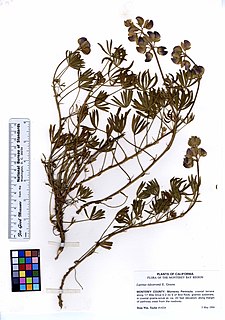
Lupinus tidestromii is a rare species of lupine known by the common names clover lupine and Tideström's lupine. It is endemic to the coastline of California just to the north and south of the Golden Gate in Sonoma, Marin, and Monterey Counties. It is a plant of the sand dunes at separate beach locations in these counties. A very limited amount of this plant's habitat remains; it is a federally listed endangered species. Construction of golf courses on the Monterey Peninsula caused the extirpation of two known occurrences, and boardwalks were built at Asilomar State Beach to prevent trampling of the delicate dune habitat there.
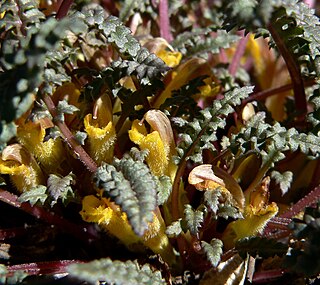
Pedicularis semibarbata, known by the common name pinewoods lousewort, is a species of flowering plant in the family Orobanchaceae.
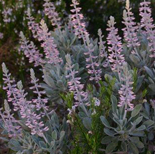
Lupinus aridorum is a rare species of lupine known by the common name scrub lupine. It is endemic to Florida in the United States, where there were 10 known populations remaining in 2003. Fewer than 6000 individual plants were counted. It is threatened by the loss and degradation of its habitat. The scrub lupine is a federally listed endangered species of the United States.

Lupinus arcticus is a species of flowering plant in the legume family known by the common names Arctic lupine or subalpine lupine. It is native to northwestern North America, where it occurs from Oregon north to Alaska and east to Nunavut. It is a common wildflower in British Columbia.



















